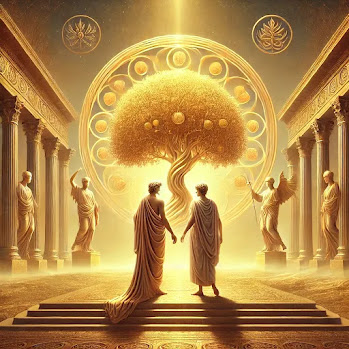The allure of the heavens and the destiny of the virtuous have fascinated minds across epochs. Cicero, in the Somnium Scipionis from his De Republica, and Dante, in his Divina Commedia, particularly in Paradiso, offer two sublime visions of the celestial realms where souls reside in triumph. Separated by centuries and cultural milieus, these masterpieces converge in their portrayal of an ethereal ascent and the eternal rewards for virtuous lives. Their synergy illuminates humanity’s quest for meaning, painting a vivid tapestry of cosmic harmony and moral order.
Cicero’s Somnium Scipionis portrays a universe meticulously structured in nine concentric spheres, as described in a dream experienced by Scipio Aemilianus. Transported to the heavens, Scipio converses with his ancestor, Scipio Africanus, who unveils the structure of the cosmos and the destiny awaiting the just. The outermost sphere contains the eternal orbits of stars, symbolizing the divine realm. Within this structure, seven planetary spheres rotate in the opposite direction of the heavens, culminating in the Moon, the lowest celestial body. At the very center lies Earth, immobile and transient, representing the realm of mortality. The harmonious order of these spheres reflects a cosmic music—a divine melody inaudible to human ears yet signifying balance and reason.
Africanus emphasizes that the virtuous, particularly those who dedicate themselves to civic duty, ascend to the Milky Way, a celestial residence symbolizing eternal glory. This vision exalts Stoic ideals, aligning virtuous living with universal harmony and portraying immortality as the reward for selfless contribution to the greater good. The grandeur of this cosmic perspective inspires contemplation of eternity and humanity’s place within a vast, ordered universe.
In contrast, Dante’s Paradiso presents a Christian cosmos, where the ascent through the celestial spheres reflects the soul’s journey toward Divine Proximity. Each of Dante’s ten spheres is governed by angelic orders and inhabited by souls whose earthly lives exemplified specific virtues. Guided by Beatrice, Dante encounters radiant spirits who reveal the interplay between Divine Grace and human free will, culminating in a vision of God within the Empyrean—the realm beyond physical existence, where divine perfection reigns.
The celestial hierarchy in Paradiso begins with the Moon, where souls who faltered in their vows reside. Subsequent spheres ascend through Mercury (ambitious spirits), Venus (spirits of love), and the Sun (luminaries of wisdom, such as Thomas Aquinas). Mars honors warriors for the faith, while Jupiter celebrates the just, and Saturn hosts contemplative spirits. The eighth sphere, the Fixed Stars, symbolizes divine goodness, leading to the Primum Mobile, the source of all motion, and finally the Empyrean, where ultimate communion with the Divine occurs. Each sphere reflects increasing alignment with God’s will, illustrating a moral order that ties earthly virtue to celestial reward.
While both Cicero and Dante extol virtue as the pathway to transcendence, their frameworks diverge significantly. Cicero’s Stoicism prioritizes reason and civic virtue, emphasizing the impersonal harmony of the cosmos. In contrast, Dante’s Christian theology celebrates Divine Love and Grace as essential to salvation, portraying the heavens as radiant and infused with joy. For Cicero, immortality is a reward for public service and adherence to reason, while for Dante, it is the soul’s ultimate fulfillment in intimate communion with the Divine.
Despite these differences, both works share a profound reverence for the virtuous soul’s ascent. Cicero’s Milky Way and Dante’s luminous spheres inspire awe, inviting readers to transcend temporal concerns and align their lives with higher ideals. The rational harmony of Cicero’s cosmos and the luminous beauty of Dante’s heavens reflect humanity’s eternal quest for meaning, bridging philosophy and faith.
The celestial visions of Cicero and Dante are more than depictions of the afterlife; they are meditations on the human condition. They challenge us to ponder our own paths—to live lives guided by Virtue, Wisdom, and Love—and to imagine the triumph awaiting the soul that soars beyond temporal confines. These masterpieces remind us that the ultimate journey is one of transcendence, unity, and purpose within the infinite expanse of the cosmos.
References
http://www.gianfrancobertagni.it/materiali/filosofiaantica/scipione.pdf)
https://resources.saylor.org/wwwresources/archived/site/wp-content/uploads/2012/07/Engl4094.1.6.pdf





